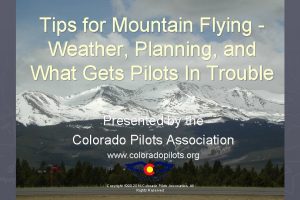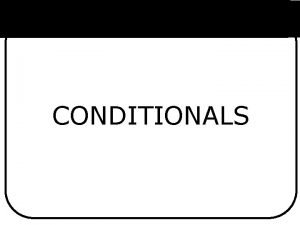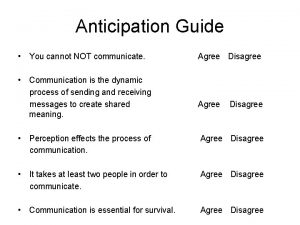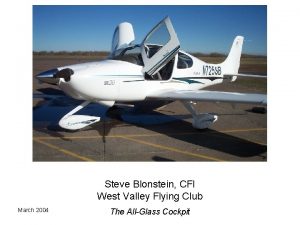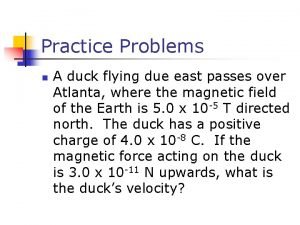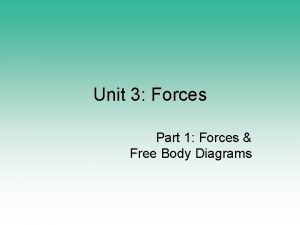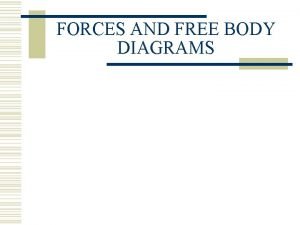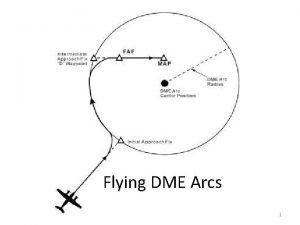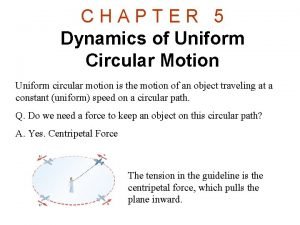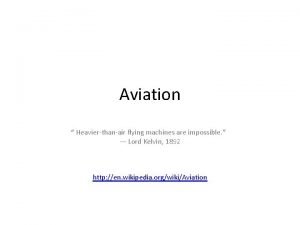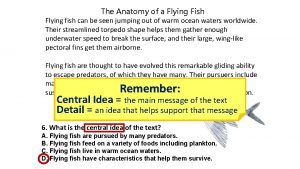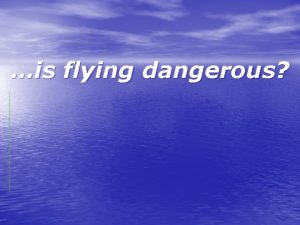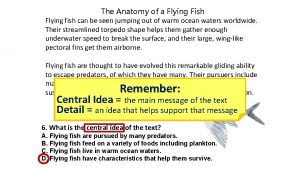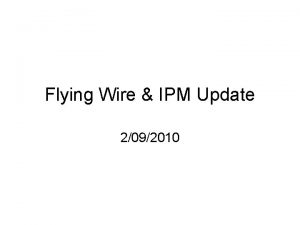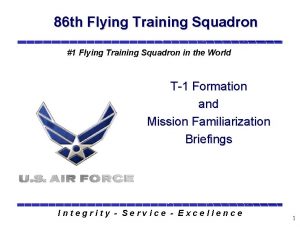Mountain Flying How NOT to die Mountain Flying




























































- Slides: 60

Mountain Flying How NOT to die…

Mountain Flying

Mountain Flying • Weather and Flight Planning – Downdrafts & Updrafts – Turbulence, Rotors, Wind Shear – Density Altitude • Clearing Mountains • Landing • Ground Speed & TAS vs. IAS

Mountain Flying • • • Takeoff Distance Oxygen Forced Landings Course Reversal Emergency Gear Controlled Flight into Terrain (CFIT)

Weather and Flight Planning üMountain weather can change rapidly üCheck forecasts üContact Flight Watch (122. 0) often üColder temps greater chance for icing üFly early morning or late afternoon for lightest winds.

Weather and Flight Planning ü VFR over high terrain may be impossible üEven though your departure/destination airports are experiencing good weather. üColorado Pilots Association recommends at least 15 Miles visibility.

Weather and Flight Planning üMountain flying is not a guaranteed go. üCheck the forecast, and then test the waters. üIf you like what you see initially, proceed; üIf not, turn back. üDon't become too attached to completing your flight. üDon’t go if the weather is doubtful.

Weather and Flight Planning üIf stopping at multiple airports, use multiple flight plans. üIn general, if you’ll be stopping at multiple airports on a flight, it’s a good idea to use multiple flight plans. üIf your plane goes down in between two airports, search crews will have a much better idea of where to look. üIf one leg takes a bit more or less time than planned, the clock is reset when you open your next flight plan.

Weather and Flight Planning üMake sure you know the winds aloft and at your destination airports. üTry to plan your route so you are flying on upwind side of valleys and canyons. üAlways know where the wind is coming from.

Weather and Flight Planning üRotors/wind shear are basically guaranteed at 20 kts, üEspecially on the lee side of a peak/ridge. üUse visualization to determine possible downdraft areas. üAir behaves like water. Ask yourself, "What would water do if it were flowing like the winds aloft? ”

Weather and Flight Planning üThe venturi effect in mountain passes can increase wind velocity significantly. üThis can produce winds in passes that are much stronger than winds aloft. üExpect wind to be much greater velocity over mountain passes than reported in areas a few miles away.

Weather and Flight Planning ü Winds aloft greater than 30 knots at cruise altitude usually means the novice pilot should delay or postpone the flight until more favorable conditions prevail.

Weather and Flight Planning üWhen approaching a ridge: üInbound: fly at 45 degree angle when ¼ to ½ mile out üOutbound: fly straight out (90˚ angle) üget away as quickly as possible üDowndrafts can be smooth or rapid/jolting üMonitor the VSI üA typical downdraft will produce a 1000 to 1500 fpm descent

Weather and Flight Planning üIf caught in a downdraft üApply max power, Lean (for best power) üDo not pull up! üIt’s very common for people to pull up and then stall or enter a spin. üPeople will often pull up and try to increase rate of turn by adding rudder. üThis is a perfect recipe for entering a spin at high altitudes.

Weather and Flight Planning üFly away at VA üThis may increase rate of descent, but it will get you out of downdraft as quickly as possible. üThe further you are from a ridge, the less turbulence and downdrafts you will experience.

Weather and Flight Planning 1. Downdrafts on lee side of mountain updrafts on windward 1. If you get caught in a downdraft, look for an area where the wind may be rising. 2. Find rising air and then perform shallow turns to remain in the updraft. 2. It may be necessary to fly toward a windward slope or some distance downwind before the aircraft can establish a positive rate of climb.

Weather and Flight Planning üMost accidents caused by downdrafts are due to the pilot's concern about altitude loss. üDon’t try to out-climb a downdraft. üInstead, try to escape away from the ridge that is causing the downdraft.

Weather and Flight Planning üIf lift (updrafts/downdrafts) is not a factor, fly on the appropriate side of the valley so that your 180˚ exit turn can be made into the wind.

Weather and Flight Planning üEstablish 2000 to 3000' clearance over mountains üPlan to cross mountains at least 2, 000 feet above the highest point along the route. üThis altitude should be reached well in advance, as some terrain will rise faster than the aircraft climb rate.

Weather and Flight Planning üLenticular clouds = extreme turbulence üMountain waves can extend for tens or hundreds of miles üIn heavy turbulence, fly an attitude and accept altitude loss üDon't over-stress the airframe

Weather and Flight Planning üDon’t rely on cloud shadows for wind direction üExpect the wind to be constantly changing in direction and velocity because of modification by mountain ridges and canyons. üDon’t fly the middle of a canyon. üThis places you in a poor position to make a turnaround and it subjects you to shear turbulence. üFly on the downwind side of canyons to catch updrafts.

Weather and Flight Planning üIf you need to make a tight turn slow down. üFlying slower provides for a more reaction time and a tighter turning radius.

Weather and Flight Planning üThere are three important factors that affect air density: altitude, temperature, and humidity.

Weather and Flight Planning ü Calculate density altitude before your flight. ü Density altitude is the altitude the airplane thinks it is at and performs in accordance with. ü High, hot, and humid conditions may raise the effective physical altitude of an airstrip to a performance altitude many thousands of feet higher than its actual elevation. ü Be familiar with the performance of your aircraft at altitude: service ceiling, takeoff and landing distance, climb rate. ü The horsepower output of the engine is decreased because its fuel air mixture intake is reduced. ü Normally aspirated engines lose about 3 percent of their horsepower for each 1, 000 feet above sea level. ü For a normally aspirated engine, the maximum power you can generate at 7500’ is 75%. ü The propeller develops less thrust because the blades are less efficient. ü The wings develop less lift because the less dense atmosphere exerts less force on the wings as airfoils. As a result, the takeoff distance is increased and the climb performance reduced.

Weather and Flight Planning ü Know the performance of your airplane: ü VY decreases with altitude. ü As a rule of thumb, subtract 1 kt for every 1, 000 feet of density altitude. ü VG decreases as weight decreases. ü As a rule of thumb, VG decreases 2 kts for every 10% under maximum gross weight. ü Weight and density altitude are the two most important factors when considering the appropriate airspeed to fly for best rate of climb or best glide. ü Learn to interpolate to figure the proper performance data before you need it. ü Don't use short field flap settings for high density altitude takeoffs (unless the field is truly short. ) ü Short field flap settings offer a better angle, not rate of climb. ü At the typically long high-elevation airports flaps will be a hindrance to reaching VY more quickly.

Weather and Flight Planning üA good way to compensate for lower power is to be light. üAs a rule of thumb, being 10% under maximum gross weight provides a 20% performance benefit over the POH numbers.

Clearing Mountains üThe visual aspects of mountain flying can be deceiving. übut if you can see more and more of the terrain on the other side of the ridge you are approaching, you are higher than the ridge and can probably continue. üPlan every ridge crossing as though an engine failure was imminent.

Clearing Mountains üBASIC PREMISE #1 üAlways remain in a position where you can turn toward lowering terrain. üThis axiom also encompasses the idea that you will not enter or fly in a canyon where there is not sufficient room to turn around. Another way of stating this truth is to have an escape route in mind and be in a position to exercise this option. • Sparky Imeson “The Mountain Flying Bible”

Clearing Mountains ü BASIC PREMISE #2 ü Do not fly beyond the point of no return. ü This is the position when flying upslope terrain where, if you reduce throttle to idle and begin a normal glide, you will have sufficient altitude to turn around without impacting the terrain. ü As you near the ridge, when arriving at a position where the power can be reduced to idle and the airplane will glide to the top of the ridgeline, a commitment to cross the ridge can be made. ü At this position, the airplane is close enough to the ridgeline not to experience an unexpected downdraft of a nature that will cause a problem. ü If a downdraft is encountered, keep the power on, lower the nose to maintain airspeed and the airplane will clear the ridge. • Sparky Imeson “The Mountain Flying Bible”

Clearing Mountains üRealize that the actual horizon is near the base of the mountains. üThis mistake of using the summit of the peaks as the horizon will result in the aircraft being placed in an attitude of constant climb. üThis could inadvertently lead to stall from which a recovery may be impossible.

Landing üLanding at a short mountain strip requires exact airspeed control to eliminate float. üA 10% increase in the proper approach speed results in a 21% increase in landing distance.

Landing ü Make sure to richen mixture for go-around ü Momentarily increase to full power when close to pattern altitude, but makes sure you have enough time to loose the airspeed you’ve gained. ü Richen to 50˚ – 100 ˚ rich of peak EGT. ü (50 ˚ is good for small engines, 100 ˚ good for high performance) ü Depending on your altitude, cruise power at high elevation is likely to also be maximum power. ü If this is the case, your fuel-air mixture is already properly set and requires no adjustment for landing. ü See your airplane’s POH for the manufacturer’s recommended leaning procedures.

Landing ü"The most common problem for flatlanders is the tendency to fly the approach below the normal indicated airspeed for landing. Thus, an area of heavy emphasis for mountain flying is to fly by the numbers and approach to land at the normal indicated airspeed. “ - Colorado Pilots Association

Landing üFor safety from eddies, wind shear, and gusty conditions, plan your approach using the runway numbers as your aim point üFlare 500 feet down the runway, and try to touch down on the 1, 000 ft. marks. üHigh altitude runways are quite long and this provides insurance in case of a severe downdraft.

Landing üBe certain to use the same indicated airspeed at high-altitude airports that you use at low-altitude or sea level airports for the takeoff or for the approach to landing. üWhen flying to remote airports, before landing, first overfly the field to check for wildlife and runway conditions. üIf you haven’t landed by ½-way down the runway, you should abort the landing.

Landing üRunway Illusions: üYou’ll look high due to narrow runways üYour eyes tend to focus on rising terrain/ridges. üThis will cause you to come in high if a hill is near the runway.

Landing üSloping runways are common in mountains üThis can create illusions of being too high (upside) or too low (downslope) üThe slope will also affect takeoff and landing distance. üThis can be a very significant important factor at mountain airports.

Ground Speed & TAS vs. IAS 1. Roughly, the TAS increases by 2% over IAS for every thousand feet altitude gain. 1. This implies that at 10, 000’ the TAS will be about 20% higher (if calculated accurately it’s actually closer to 15%) 2. This is a built-in compensator for reduced lift caused by the thin air at higher altitude airports. 3. Ground speed will be much higher, visual queues will be very different. 4. Since TAS is higher, you’ll need to fly pattern wider than normal.

Takeoff Distance ü Before landing at a mountain airport, make sure you can climb back out. ü One technique you can use is to overfly the field at, say, 1500 feet AGL and apply full power. ü If you don’t achieve at least 300 fpm climb rate, you probably shouldn’t land. ü A rule-of-thumb for operating from a short runway is that if you obtain 71% of the speed necessary for rotation at the ½way point of the runway, you can take off in the remaining distance. ü Calculate this speed beforehand review it as part of your pretakeoff briefing. ü E. g. VR=55 kts - need to obtain 39 kts at ½-way point. ü The ½-way point should be treated as a solid abort point.

Takeoff Distance ü Before takeoff, you must lean for max power üFor a plane with a direct drive engine and a fixed pitch propeller, before takeoff, hold the brakes, apply full throttle, lean to peak RPM (or 50˚ – 100 ˚ rich of peak EGT). üLeave mixture at that position and accomplish the takeoff. üFor a plane with a constant speed propeller, leaning is normally done using the EGT. üSee your POH for the manufacturer’s recommendation.

Takeoff Distance üThe takeoff distance varies with the gross weight. üA 10% increase in gross weight will cause: ü 5% increase in speed required for takeoff. ü 9% decrease in acceleration (from stop to takeoff speed). ü 21% increase in takeoff distance. üYou may not want full fuel on takeoff from a high-altitude airport.

Takeoff Distance ü A good "rule of thumb" for the pilot to remember is - for each thousand feet above sea level, the takeoff run increases approximately 25 percent. ü In the case of normally aspirated engines (not turbocharged or supercharged), at an altitude of 10, 000 feet, about onehalf of available engine horsepower is lost. ü Example: Denver, Colorado: field elevation indicated on the altimeter is 5000 ft; Summer day 80˚F ü density altitude is 7500 feet ü the takeoff distance will be 2. 3 times the sea level takeoff roll. ü The double whammy: not only must the airplane be at a higher true airspeed to achieve flying speed, but it must do so with an engine that's not capable of making sea level horsepower.

Oxygen ü Density altitude can be much higher than indicated ü The effect of altitude on your body depends on the partial pressure of oxygen. ü Note that altimeters show pressure altitude (corrected for local altimeter setting). ü The U. S. Air Force recommends using oxygen starting at 8000 ft. ü FAA regulations ü No O 2 required until 12500 (although not required, it is recommended) ü Between 12500 and 14000, after ½ hour ü Higher than 14000, continuous ü Higher than 15000, must be provided for passengers

Oxygen ü Night vision is inhibited above 5000’ pressure altitude. ü Cannulas can't be used above 18000' ü Manufacturers prohibit use above this altitude. ü Above this altitude, up to 25, 000’ you can use an oxygen mask. ü Regulator and flow meters fail, valves freeze, and lines plug up, so always be prepared to descend. ü It may make sense, because of the increased risk, to plan a flight at, say, 16, 000’ vs. 22, 000’. ü The time of useful consciousness at 20, 000’ is 30 minutes ü At 22, 000’, the time of useful consciousness is about 10 minutes. ü Time of useful consciousness is sometimes also referred to as EPT, or Effective Performance Time.

Oxygen üOxygen bottles are normally low pressure ü 500 PSI, or high pressure ü 1800 PSI is the most common variety. üThe 1800 PSI bottles are green. üOxygen bottles need to be re-certified every 5 years.

Oxygen ü It is a good idea to consider oxygen for flights above 5, 000 feet at night and above 8, 000 feet during the day. ü Use of pulse oximeter ühttp: //www. flightstat. nonin. com/Hypoxia. pdf ü http: //www. radialsolutions. com/ ü A general rule-of-thumb for using a pulse oximeter is to never let your oxygen saturation level get more than 10 percentage points below your home (ground level) saturation level.

Forced Landings ü Don’t choose a route that would prevent a suitable forced-landing area ü In the event of a forced landing, approach at best glide, but touch down / impact at stall speed. ü Don’t leave the airplane without a compelling reason if you have executed an emergency or precautionary landing. üTemporary evacuation may be necessary if a fire hazard exists.

Forced Landings ü If you have a choice between landing in light green trees or dark green, head toward the light. üLight green trees are more pliable, younger than dark green trees. ü Don’t land in water. üYou’ll flip upside down and, since the plane won’t be visible, it’s less likely than you’ll be found. üAlso, mountain water is cold and you could contract hypothermia.

Forced Landings üFollow roads whenever possible. üAvoid flying over open water (Lake Tahoe, e. g. ). üPlan your trip along routes that include populated areas and well-known passes, or over valleys whenever possible.

Forced Landings üFollow roads whenever possible. üAvoid flying over open water (Lake Tahoe, e. g. ). üPlan your trip along routes that include populated areas and well-known passes, or over valleys whenever possible. üSwaths cut through trees are usually power lines. It’s usually best to avoid them.

üELT Forced Landings üLearn how to turn it on. üThe ELT may not turn on automatically in a forced landing, so you may need to arm it manually.

Course Reversal ü Everyone flying in the mountains will encounter situations when it becomes necessary to make a 180˚ turn. üTo turn around, slow down. This will decrease the radius of turn. üPull back on the control wheel to trade airspeed for altitude if you have extra speed. üThen make the steepest turn you can comfortably make, up to 60 degrees. ü To execute a course reversal in IMC and end up over the same spot turn 90˚ followed by 270˚ üan 80˚ /260˚ also works

ü ü ü Emergency Gear Warm clothes Blankets or sleeping bags Food Water Flashlights Fire starter Radio Signaling mirror Maps Compass Wear or bring shoes you can use for hiking ü Always bring emergency gear when flying in the mountains.

Controlled Flight Into Terrain üControlled Flight into Terrain (CFIT) occurs when an airworthy aircraft under the control of a pilot is inadvertently flown into terrain, water, or an obstacle with inadequate awareness on the part of the pilot of the impending disaster. üCumulo-granite

Controlled Flight Into Terrain ü Accidents occur most frequently in GA operations ü 4. 7% of all GA accidents and 32% of GA accidents in IMC. ü On average there are 1. 4 fatalities per CFIT accident, versus 0. 33 fatalities per GA accident overall. ü 17% of all GA fatalities are due to CFIT ü CFIT accidents are fatal 58% of the time. ü CFIT accidents occur 64% of the time in daytime and 36% at night ü 51% of CFIT accidents occur in IMC, 48% in VMC and 1% unknown. ü Impacted terrain was flat 45% and mountainous 55%.

• • • Controlled Flight Into Terrain NTSB Identification: DEN 07 FA 054 14 CFR Part 91: General Aviation Accident occurred Wednesday, January 17, 2007 in Centennial, WY Aircraft: Piper PA-28 -180, registration: N 43630 Injuries: 3 Fatal. This is preliminary information, subject to change, and may contain errors. Any errors in this report will be corrected when the final report has been completed. On January 17, 2007, approximately 2215 mountain standard time, a Piper PA-28180, N 43630, registered to Archer Nevada LLC, and piloted by a private pilot, was destroyed when it impacted mountainous terrain during cruise flight, 6 miles northwest of Centennial, Wyoming. Night visual meteorological conditions prevailed. The personal flight was being conducted under the provisions of Title 14 Code of Federal Regulations Part 91 on a visual flight rules flight plan. The pilot and his two passengers were fatally injured. The cross-country flight departed the Rock Springs. Sweetwater County Airport (RKS) approximately 2115, and was en route to Grand Island, Nebraska (GRI).

Controlled Flight Into Terrain • According to Blue Ridge Aeronautics, a flight school in Vacaville, California, the flight departed Nut Tree Airport (KVCB) approximately 1100 Pacific standard time. The flight was to travel to Grand Island, Nebraska, on the 17 th and continue on to Chicago, Illinois, on the 18 th. The pilot reported to the flight school that he intended to follow Interstate 80 for the entire flight. According to the airport manager in RKS, the airplane arrived approximately 2030 and obtained fuel services. The airplane did not arrive in GRI and an Alert Notification (ALNOT) was issued for the missing airplane. According to National Track Analysis Program (NTAP), the airplane was tracked from RKS to 10 miles west of Centennial. Search and rescue crews located the airplane wreckage approximately 0830 on the morning of January 19 th.

• Controlled Flight Into Terrain The National Transportation Safety Board investigator-in-charge arrived on scene approximately 1300 on January 19, 2007. The accident site was located in mountainous, forested, snow covered terrain. A global positioning system receiver reported the coordinates of the main wreckage as 41 degrees 21 minutes 58. 6 seconds north latitude, and 106 degrees 15 minutes 29. 6 seconds west longitude. The accident site was at an elevation of 10, 710 feet mean sea level and the airplane impacted on a magnetic heading of 260 degrees. The wreckage consisted of the fuselage, empennage, and the left wing. The right wing separated partially and was found adjacent to the belly of the fuselage. The wreckage came to rest inverted in approximately 3 to 5 feet of snow. The closest official weather observation station was Laramie Regional Airport (KLAR), Laramie, Wyoming, located 27 nautical miles (nm) east of the accident site. The elevation of the weather observation station was 7, 278 feet msl. The routine aviation weather report (METAR) for LAR, issued at 0953, reported, winds, 290 degrees at 9 knots, gusting to 18 knots, visibility, 10 statute miles; sky condition, clear; temperature minus 10 degrees Celsius (C); dewpoint, minus 18 degrees C; altimeter, 29. 94 inches.

Controlled Flight Into Terrain

Further Study 1. For Further Study 1. http: //www. mountainflying. com/ 2. Books by Sparky Imeson 1. “The Mountain Flying Bible” 2. “The Shirt Pocket Mountain Flying Guide” 1. Order them here: https: //secure. airbase 1. com/mtnflying/orders. asp 3. "Hypoxia, Oxygen and Pulse Oximetry, " Furgang, Fred, MD. 1. http: //www. flightstat. nonin. com/Hypoxia. pdf 4. Pulse Oximetry and the Oxyhemoglobin Dissociation Curve 1. http: //www. continuingeducation. com/nursing/pulseox. pdf
 Die mier en die sprinkaan fabel pdf
Die mier en die sprinkaan fabel pdf Mountain flying tips
Mountain flying tips Not genuine, not true, not valid
Not genuine, not true, not valid Die kinder verbringen die ferien
Die kinder verbringen die ferien Je höher die berge desto schöner die gams
Je höher die berge desto schöner die gams Voorbeelde van korttermyn doelwitte
Voorbeelde van korttermyn doelwitte Die hippies die
Die hippies die Die einde van die koue oorlog 1989
Die einde van die koue oorlog 1989 Belydenis van geloof ek glo in god die vader
Belydenis van geloof ek glo in god die vader Die pad van waarheid tot die lewe
Die pad van waarheid tot die lewe Lydende vorm voorbeelde
Lydende vorm voorbeelde 2folie
2folie Jys die stem in die stilte wat agterbly
Jys die stem in die stilte wat agterbly Rosen die ich an dich verschenke
Rosen die ich an dich verschenke Het is niet die ene druppel die de emmer doet overlopen
Het is niet die ene druppel die de emmer doet overlopen Die vorhaut ist die haut spruch
Die vorhaut ist die haut spruch Seun van magol 1 kon 4
Seun van magol 1 kon 4 Pad van waarheid tot die lewe
Pad van waarheid tot die lewe Voegwoorde groups
Voegwoorde groups If you don't water the plants they die
If you don't water the plants they die To not die chap 18
To not die chap 18 If you are not confused you're not paying attention
If you are not confused you're not paying attention Casual vs informal
Casual vs informal Attention is not explanation
Attention is not explanation Not too broad and not too narrow
Not too broad and not too narrow P then q
P then q Just about right scale
Just about right scale Love is not all about
Love is not all about Ears that hear and eyes that see
Ears that hear and eyes that see P no l l no l om p pp
P no l l no l om p pp You cannot control what you cannot measure
You cannot control what you cannot measure We will not be moved when everything around is shaking
We will not be moved when everything around is shaking Not a rustling leaf, not a bird in flight
Not a rustling leaf, not a bird in flight You can not not communicate
You can not not communicate Zechariah 5 niv
Zechariah 5 niv The bird is flying above my head
The bird is flying above my head The water frame richard arkwright
The water frame richard arkwright Doofas the dinosaur
Doofas the dinosaur Flying shoot adalah
Flying shoot adalah Family syllables
Family syllables West valley flying club
West valley flying club A duck flying due east passes over atlanta
A duck flying due east passes over atlanta Industrial revolution flying shuttle
Industrial revolution flying shuttle Flying shuttle noon at ngayon
Flying shuttle noon at ngayon Mahua enjoys flying kites
Mahua enjoys flying kites Flying shuttle
Flying shuttle Piers smerdon
Piers smerdon Amelia syllables
Amelia syllables Tactical formation flying
Tactical formation flying Kite fighting techniques
Kite fighting techniques Free body diagram flying squirrel
Free body diagram flying squirrel Pastafarian prayer
Pastafarian prayer Loosely packed snow
Loosely packed snow Dme arc approach
Dme arc approach A jet flying at 123 m/s banks
A jet flying at 123 m/s banks Heavier than air flying machines are impossible test
Heavier than air flying machines are impossible test Primary and supporting instruments
Primary and supporting instruments What do flying fish eat
What do flying fish eat A speeding bus makes contact with a bug that splatters
A speeding bus makes contact with a bug that splatters The bird flying gracefully through the air
The bird flying gracefully through the air The bird flying gracefully through the air
The bird flying gracefully through the air

